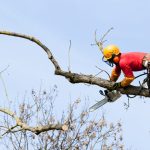Trimming Douglas Fir Trees
Douglas fir trees are easy to maintain, do well in almost any soil type and climate, and are highly resistant to disease and insect infestations, so they can grow to great size. So knowing the process of trimming Douglas fir trees can come in handy if you have these majestic trees in your backyard.
These evergreen trees provide dense shade with their lush green needles in the Summer and remain green during the Winter months. Douglas Firs are also very versatile when it comes to landscaping design. These trees come in varying shapes and sizes so they can be planted along walkways or placed near patios and decks. Trimming these trees becomes all the more important in these sometimes tight areas.
Trimming Douglas Fir Trees
Trimming, also known as pruning, is done for a variety of reasons, such as improving tree health, maintaining shape, promoting growth, and managing potential hazards. Here’s a general process for trimming Douglas fir trees.
Timing
The best time to prune your Douglas fir is during its dormant season – which is typically in late winter or late summer. While it may be tempting to trim your tree whenever you see fit, pruning during the dormant season is actually best for the tree’s overall health.
By doing so, you’ll minimize stress on the tree and reduce the risk of disease or insect infestation. So go ahead and grab those pruning shears – just make sure to choose the right time of year to use them! Your Douglas fir will thank you and repay you with years of beauty.
Tree Assessment
Before grabbing your pruning shears, it’s important to assess the condition of the tree and the branches you intend to cut. Keep an eye out for any diseased, damaged, or dead branches that need to be removed to keep the tree healthy. If you’re using a ladder to reach higher branches, make sure they can comfortably support your weight where the ladder is placed.
Pay attention to the tree’s shape and growth pattern to determine if any corrective pruning is necessary. Taking the time to evaluate the tree before pruning ensures that you preserve the tree’s health while also maintaining its natural beauty.
Begin Your Trim
Start by removing dead, diseased, or damaged branches. Cut these branches back to healthy wood, making clean cuts just outside the branch collar (the swollen area where the branch attaches to the trunk or larger branch). Make sure to remove anything in the “drop zone,” such as lawn furniture, pets, kids, etc.
If the tree is excessively dense or crowded, selectively remove some branches to improve air circulation and light penetration. Avoid removing more than 20-25% of the live foliage in a single season. You want to make sure you aren’t harming the tree when you’re actually trying to help the tree.
Are you trimming the tree to help shape it or control the size? Prune branches selectively to promote a balanced and aesthetically pleasing appearance. Avoid excessive pruning on the lower part of the tree as it can disrupt the natural taper. If the lower branches obstruct walkways or hinder visibility, avoid removing too many lower branches as they provide structural support to the tree.
For smaller branches, make a clean cut just above a bud or lateral branch. Angle the cut away from the bud at a 45-degree angle. For larger branches first make an undercut about 12 to 18 inches away from the trunk then make a top cut slightly farther out from the undercut, allowing the branch to fall. Finally, make the final cut just outside the branch collar.
Take Care When Cutting
When it comes to trimming a douglas fir, it’s crucial to prioritize safety above all else. This means using the appropriate safety equipment, such as gloves, goggles, and a helmet. Additionally, be aware of any falling branches or debris, and work cautiously.
While you may be tempted to trim the tree extensively, keep in mind that this can actually weaken the tree and make it more susceptible to disease or stress. If the tree is particularly large, requires significant pruning, or involves working at heights, it may be best to hire a professional arborist who can handle the job safely and effectively.
Not Sure About Trimming Douglas Fir Trees on Your Own? Call the Experts!
Trimming is not just about shaping aesthetically pleasing tree branches, but about ensuring the overall health and longevity of the tree. Inexpensive Tree Care understands the science behind tree growth and will only trim the right amount, in the right places, to guarantee that your tree will thrive for years to come.
Our certified arborists have the knowledge and expertise to evaluate your trees and provide them with targeted care. We pride ourselves on providing quality work that satisfies our customers’ needs. So if you’re looking for a team of professionals to keep your trees healthy and beautiful, reach out to Inexpensive Tree Care today!




